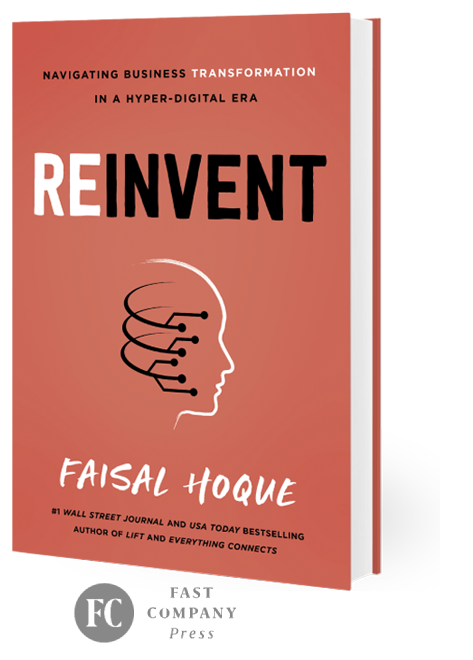Commitment, Timeframe Matters When Remaking Your Organization
[This article is adapted from the book REINVENT (Fast Company, 2023) by Faisal Hoque.]

An old cliché holds that nothing worthwhile is ever easy to achieve.
While something of a catchphrase, that’s undoubtedly the case when it comes to the challenges of transforming your business.
For one thing, the implications of transformation are far more comprehensive and impactful than they used to be. This is not merely a case of deciding to use a new software accounting program or updating your fleet of vehicles. This has to do with most everything your organization does and stands for, from the way work is performed to where that work actually takes place.
Moreover, the odds for missteps and even outright failure are significant. For instance, a Harvey Nash/KPMG CIO Survey pointed out that only 18 percent of companies rate their use of digital technology as “very effective.” Other research points to a similar conclusion—reinvention is a decidedly tough nut.
That makes a thorough understanding of the varied challenges of transformation central to a successful journey toward an utterly new, more prosperous organization. Here are a few things to bear in mind:
Lack of top tier commitment. If the leaders aren’t fully on board, chances are others throughout the organization are likely to follow suit. If need be, take extra time to align leadership commitment and support. For instance, the more you can delineate benefits—higher profits, greater employee retention, to name just two–the better the chances of gaining management buy-in.
Take your time. Continuing the cliché parade, Rome wasn’t built in a day, and neither will your digital transformation. Set a reasonable pace to ensure support as well as the necessary steps to actually implement reinvention changes.
Establish clear objectives. Fuzzy promises such as greater efficiency and flexibility are fine up to a point—they can become problematic if that’s all you’re talking about. Instead, make sure that your goals are straightforward and easy to grasp. As I cite in my book REINVENT, try using the principle embodied by the acronym SMART:
- If you’re hoping to achieve savings goals, where?
- What yardsticks are in place to measure savings?
- Is the plan aggressive but reasonable? An insurance company that dreams of cutting its underwriting costs in half within a year’s time is experiencing just that—a fantasy. However, the goal of a 20 percent reduction achieved systematically over a five-year period is not only more reasonable, but also engenders greater overall confidence.
- Why do you want to save all this money? Will it be redirected back within the company to improve employees’ work lives?
- Time-Bound. Not just how the entire process will take, but also benchmarks along the timeline where significant progress can be marked—yet another form of encouragement to everyone to stay the course.
Understand that change can be intimidating. What seems like a sweeping, exciting form of transformation to one person may terrorize another who can only foresee widespread disruption, uncontrolled activity and even chaos. Begin by employing complete transparency—if there’s risk involved, talk about it, but just be sure to address how you’re specifically going to try to mitigate possible downsides. Look to other organizations for reinvention challenges and how they dealt with them.
Emphasize the necessity. It’s essential to help anxious colleagues understand that transformation is no longer an attractive option but absolutely essential—critical to growing and even surviving in a market in which competitors across the spectrum are considering or have already embarked on such reinvention. However unnerving to some, it’s an environment where the question boils down to transform or deteriorate.
Avoid undue emphasis on just the technology. Even those who are fairly distanced from technology can be drawn into the allure of it. All the shiny new equipment, not to mention the possibilities that it can engender, make it very easy to get caught up in technology for technology’s sake. But, at the end of the day, it is the people impacted by all this technology that really matter. Think about how will they be affected by all this change. Take them into account when it comes to deciding the elements of the transformation
Don’t understate the impact of culture change. Don’t assume, as many organizations do, that once there’s new technology in place, the entire transformation is complete. Not in the least. Digital transformation actually has relatively little to do with the technology itself. Rather it’s about the organization itself—how adaptive it is, how comfortable it is with flexibility and how ready it is to shed habits and mindsets of the past in favor of new, more applicable ones. Using some of the strategies outlined above, communicate the pervasive impact of all that’s new—change that goes far beyond new tools and tech. Emphasize whatever training and education may be needed to strengthen culture recognition and acceptance
Understand that it’s a journey with no real end point. Transformation is never a one-and-done proposition. There will always be new things to learn and new challenges and opportunities, not to mention an ongoing flow of new technology itself displacing what came before it. Adjust your attitude to this more malleable mindset and you’ll skirt the mistake that everything’s finished and you can just sit back and relax—as you watch your competitors who recognize a much longer timeframe are busy putting the distance between themselves and you. Make sure you’re ahead of them and not the other way around.
© 2022 by Faisal Hoque. All rights reserved.















